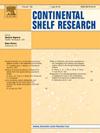舟山群岛附近上升流中水流-地形相互作用和潮汐混合的重要作用
IF 2.2
3区 地球科学
Q2 OCEANOGRAPHY
引用次数: 0
摘要
沿海上升流在海洋生物地球化学环境中起着至关重要的作用,它将富含营养的深水带到海面,从而促进了高生物量渔场的发展,如中国舟山上升流系统。高分辨率的二级卫星海温(SST)数据捕获了舟山群岛显著的上升流事件,即使在持续超过一周的北风不利条件下也是如此。进一步的分析表明,这些不利于上升流的风不仅产生了陆上Ekman运输,还引起了负的风应力旋度,这两者都起到了抑制上升流的作用。然而,加权累计地形位置指数在不利风的作用下仍表现出准稳定的上升流强度。在有利上升风作用下,舟山群岛近海以北海岸流为主,而在不利上升风作用下,以南海岸流为主。舟山群岛的特点是由两个岛链形成的两个突出的经向地形斜坡。当向北或向南的海岸流与这些斜坡相互作用时,在面向河流的一侧发生上坡运动,促进更深的冷水上涌。此外,在岛屿周围的浅水中,强烈的潮流流产生强烈的潮汐混合,进一步加强了较冷的水向上输送到表面。岛屿附近局部增强的水流-地形相互作用、潮汐混合和背风上升流共同触发了岛屿周围多个冷上升流核,导致舟山群岛周围上升流的空间分布呈非均匀性。本文章由计算机程序翻译,如有差异,请以英文原文为准。
The vital role of current-topography interaction and tidal mixing in the upwelling around Zhoushan Archipelago
Coastal upwelling plays a critical role in the marine biogeochemical environment by bringing nutrient-rich deep water to the surface, thereby fostering the development of high-biomass fishing grounds, such as the Zhoushan upwelling system in China. High-resolution Level-2 satellite-derived Sea Surface Temperature (SST) data captured notable upwelling events in the Zhoushan Archipelago, even under persistent northerly upwelling-unfavorable winds lasting over one week. Further analysis revealed that these upwelling-unfavorable winds not only generated onshore Ekman transport but also induced a negative wind stress curl, both of which acted to suppress upwelling. However, the weighted cumulative topographic position index demonstrated a quasi-steady upwelling intensity despite the unfavorable wind forcing. Under upwelling-favorable winds, a northward coastal current dominates the Zhoushan Archipelago offshore region, whereas a southward coastal current prevails under upwelling-unfavorable winds. The Zhoushan Archipelago features two prominent meridional topographic slopes formed by its two island chains. When northward or southward coastal current interacts with these slopes, upslope motion occurs on the stream-facing side, facilitating the upwelling of deeper cold water. Additionally, strong tidal current within the shallow waters surrounding the islands generates intense tidal mixing, further enhancing the upward transport of colder water to the surface. The locally enhanced current-topography interaction, tidal mixing, and leeward upwelling nearby the islands collectively trigger multiple cold upwelling cores around the islands, leading to a heterogeneous spatial distribution of upwelling around Zhoushan Archipelago.
求助全文
通过发布文献求助,成功后即可免费获取论文全文。
去求助
来源期刊

Continental Shelf Research
地学-海洋学
CiteScore
4.30
自引率
4.30%
发文量
136
审稿时长
6.1 months
期刊介绍:
Continental Shelf Research publishes articles dealing with the biological, chemical, geological and physical oceanography of the shallow marine environment, from coastal and estuarine waters out to the shelf break. The continental shelf is a critical environment within the land-ocean continuum, and many processes, functions and problems in the continental shelf are driven by terrestrial inputs transported through the rivers and estuaries to the coastal and continental shelf areas. Manuscripts that deal with these topics must make a clear link to the continental shelf. Examples of research areas include:
Physical sedimentology and geomorphology
Geochemistry of the coastal ocean (inorganic and organic)
Marine environment and anthropogenic effects
Interaction of physical dynamics with natural and manmade shoreline features
Benthic, phytoplankton and zooplankton ecology
Coastal water and sediment quality, and ecosystem health
Benthic-pelagic coupling (physical and biogeochemical)
Interactions between physical dynamics (waves, currents, mixing, etc.) and biogeochemical cycles
Estuarine, coastal and shelf sea modelling and process studies.
 求助内容:
求助内容: 应助结果提醒方式:
应助结果提醒方式:


